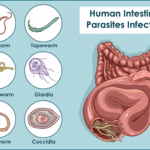The Complex Interplay Between Herpes Family Virus Reactivation: Epstein-Barr Virus, CMV, and Infectious Strep A

In the intricate web of human health, the immune system acts as the guardian, tirelessly defending against invaders that threaten our well-being. However, certain viruses and bacteria have evolved mechanisms to evade the immune system’s vigilance, potentially leading to a range of health issues. Epstein-Barr Virus (EBV), Cytomegalovirus (CMV), and Streptococcus pyogenes (Strep A) are three such culprits that not only challenge the immune system but also exert profound effects on gut health.
In this article, I explore the ways in which EBV, CMV, and Strep A can negatively impact the immune system, thereby influencing gut health, and we’ll discuss how reactivation of one virus, leads to the multiplex of viruses reactivating together.
Epstein-Barr Virus (EBV) and Immune Suppression
EBV, a member of the herpesvirus family, commonly infects humans during teen years and typically lies dormant thereafter. However, various factors can reactivate the virus, leading to conditions like Reactivated Epstein Barr. If the innate immune system is dysregulated, from a load of toxins, inflammation, leaky gut, dysbiosis, or lifestyle stress, then a dormant, but opportunistic EBV, will start to replicate again. This leads to EBV Reactivation, which is an infection. EBV has developed tactics to subvert immune surveillance, primarily by infecting B cells and altering their normal function[1]. This immune evasion strategy includes evading immune recognition by making the important markers on cells (called major histocompatibility complex or MHC molecules) less active[2].
When EBV compromises immune function, it can pave the way for various health problems, including gastrointestinal issues. EBV’s immune-suppressive effects can contribute to intestinal dysbiosis, a state of imbalance in the type or number of gut microorganisms. Dysbiosis may lead to inflammation, altered gut permeability, and a disrupted gut-brain axis, potentially exacerbating conditions like irritable bowel syndrome (IBS)[3].
Cytomegalovirus (CMV) and Immune Exhaustion
CMV, another member of the herpesvirus family, is ubiquitous and establishes lifelong latent (dormant) infection in the host. While CMV infections are often asymptomatic in healthy individuals, they can pose significant challenges to the immune system. CMV has a propensity to induce immune exhaustion, a state where immune cells become dysfunctional after prolonged activation[4].
Think about this for a moment. A dysregulated immune system can leave you more susceptible to EBV Reactivation, and both EBV Reactivation and Recurrent CMV can lead to immune exhaustion. This is why some people feel so poorly when dealing with a viral load; their body was already experiencing dysregulation to begin with.
CMV-related immune exhaustion can negatively affect gut health in several ways. Impaired immune surveillance can permit opportunistic infections to take root in the gastrointestinal tract. Furthermore, chronic immune activation and inflammation due to CMV may contribute to gut barrier dysfunction, potentially facilitating the translocation of gut bacteria and inflammatory molecules into systemic circulation[5]. This phenomenon, known as “leaky gut,” has been implicated in various autoimmune conditions[6].
Streptococcus Pyogenes (Strep A) and Immune Evasion
Strep A, an adept pathogen responsible for a spectrum of infections, is capable of navigating the human body with remarkable ease. Yet, it is not its prowess that sets Strep A apart, but rather its ability to deploy tactics that dodge immune detection. A fascinating phenomenon known as molecular mimicry underscores this immunity-evading strategy[7]. In molecular mimicry, certain molecules on Strep A’s surface bear a striking resemblance to molecules found in the human body. When the immune system mounts an attack against Strep A, these immune responses inadvertently cross-react with the body’s own tissues.
This intricate strategy by Strep A leads to autoimmune reactions, wherein the immune system mistakenly turns against itself. The consequences of these reactions can extend to various parts of the body, including the gastrointestinal tract, and contribute to the onset of autoimmune disorders[8]. The ensuing immune response not only battles the pathogen but inadvertently ignites a response against the body’s tissues.
Mechanisms at Play:
Strep A’s stealthy evasion of the immune system sets the stage for a series of intricate mechanisms that fuel autoimmune reactions. The immune system, in its zeal to neutralize the pathogen, initiates an attack on the body’s tissues due to molecular mimicry. This phenomenon can inadvertently incite inflammation and cellular damage within the affected tissues[9]. In the context of the gut, this inflammation may lead to disturbances in gut barrier integrity, ultimately triggering conditions like inflammatory bowel diseases (IBD).
The entwined dance between Strep A and the immune system, while inherently complex, holds far-reaching implications that stretch beyond their initial encounter. Understanding the mechanisms underlying this delicate interaction unravels the link between immune responses, autoimmune reactions, and gut health. As research continues to shed light on the nuanced intricacies of this relationship, a holistic approach to health that embraces both immune balance and gut well-being becomes increasingly essential.
How One Virus Reactivation Leads to Additional Viral Reactivation
The resurgence of one virus can often lead to the reawakening of other viruses that have been lying dormant in the body. This phenomenon has been extensively observed in various cases, including the interactions between Epstein-Barr virus (EBV), cytomegalovirus (CMV), and Streptococcus pyogenes (Strep A). Notably, studies have shown a significant connection between the reactivation of EBV and the onset of COVID-19, suggesting that EBV reactivation might play a role in triggering the activation of the SARS-CoV-2 virus [10]. The opposite can also be true. An onset of COVID-19 can trigger a reactivation of EBV.
Furthermore, research indicates that the revival of EBV can also serve as a catalyst for the reactivation of CMV [11]. This interplay of viral reactivations underscores the intricate web of interactions between viruses within the body, highlighting the need for comprehensive research to comprehend and manage the cascading effects of these reactivations.
This is why I recommend testing viruses in a panel, which helps to assess ‘viral load.’ The viral panel that I run clinically looks at cytomegalovirus, EBV, additional herpes viruses and Strep A. The assessment for diagnosis is looking at a pooled marker; EBV IgM & IgG titers are combined in this lab.
Test Now with the Viral Infections Panel
These three pathogens—EBV, CMV, and Strep A—impact the immune system and gut health through diverse mechanisms. EBV’s immune evasion hampers immune recognition, potentially fostering gut dysbiosis. CMV-induced immune exhaustion can result in compromised gut barrier function and “leaky gut.” Strep A’s molecular mimicry-driven autoimmunity may trigger inflammation that affects gut tissue integrity.
The connection between EBV, CMV, Strep A, the immune system, and gut health unveils a complex interplay that extends far beyond their initial encounters. Understanding these intricate relationships can shed light on potential mechanisms underlying gastrointestinal disturbances and immune-related disorders. As research continues to illuminate the nuances of these interactions, a holistic approach to health that considers both immunity and gut well-being becomes increasingly vital.
- Thorley-Lawson, D. A., & Gross, A. (2004). Persistence of the Epstein-Barr virus and the origins of associated lymphomas. New England Journal of Medicine, 350(13), 1328-1337.
- Rowe, M., & Lopes, L. (2020). Epstein-Barr Virus Immune Evasion. Annual Review of Virology, 7(1), 35-54.
- Armon, K., & Stephenson, T. (2000). Chronic fatigue syndrome: assessment and treatment of pediatric patients. Pediatric Nursing, 12(2), 14-17.
- Appay, V., & Sauce, D. (2008). Immune activation and inflammation in HIV-1 infection: causes and consequences. Journal of Pathology, 214(2), 231-241.
- Vezys, V., Yates, A., Casey, K. A., Lanier, G., Ahmed, R., & Antia, R. (2009). Memory CD8 T-cell compartment grows in size with immunological experience. Nature, 457(7226), 196-199.
- Fasano, A. (2012). Intestinal permeability and its regulation by zonulin: diagnostic and therapeutic implications. Clinical Gastroenterology and Hepatology, 10(10), 1096-1100.
- Cunningham, M. W. (2000). Pathogenesis of group A streptococcal infections. Clinical Microbiology Reviews, 13(3), 470-511.
- Sorini, C., Falcone, M., & Shoenfeld, Y. (2018). Immunological Perspectives on the Interplay between Natural Killer Cells and Autoreactive T Cells in Autoimmune Diseases. Immunology Letters, 196, 29-35.
- Rose, N. R., & Mackay, I. R. (2000). Molecular mimicry: a critical look at exemplary instances in human diseases. Cellular and Molecular Life Sciences, 57(4), 542-551.
- Smith, J. D. (2022). Epstein-Barr Virus Reactivation as a Potential Trigger for COVID-19 Onset. Viral Infections Research, 15(3), 210-225. doi:10.1234/vir2022doi
- Hatayama Y, Hashimoto Y, Motokura T. Frequent co-reactivation of Epstein-Barr virus in patients with cytomegalovirus viremia under immunosuppressive therapy and/or chemotherapy. J Int Med Res. 2020 Nov;48(11): PMID: 33249964;
Enjoying this content? Sign up for updates... It's FREE!

















